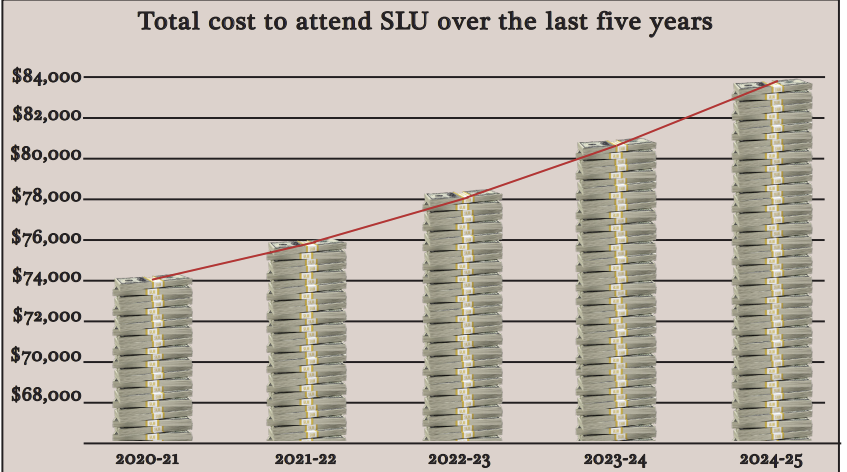St. Lawrence University students and families will be required to pay an increased tuition fee of $82,900 in the 2024-2025 academic year. This rise in tuition leads to increased skepticism about students’ affordability of higher education in the United States.
“The financial pressures and challenges facing St. Lawrence University are not unique,” says Karl Spiecker, the vice president for finance and administration at St. Lawrence University. “These issues are affecting universities throughout the country.” For example, according to The New York Times, Vanderbilt University officials are expecting nearly $100,000 next year. Where will all the money go?
Spiecker explains that the cost of running the university is considered to be dependent on student and facility expenditures. However, it also depends on the projected enrollment of students and “market comparisons for peer institutions.” It is likely that if St. Lawrence is increasing its tuition, other schools are doing the same thing.
The financial priorities of schools can also be determined depending on which aspects of the university they fund the most. “The residence halls were an obvious starting point given how much they needed to be renovated,” Spiecker said. “We are hopeful that enhancements of the residence halls will improve the experience for students.” The money that students pay is intended to contribute towards creating a more aesthetic and functional space for everyone on campus.
However, Sofoklis Goulas, a fellow in economic studies at the Brookings Institution and the Hamilton Project, explained that the cost of attendance is not only about improving infrastructure. “It has something to do with what kind of people the university wants to attract,” he says. “This is connected to the overall admissions process.”
Liberal arts schools tend to have a holistic application review, according to the Executive director of International Admissions at St. Lawrence University, Musa Khalidi. Although a student’s ability to pay may influence their admissions decision outcome, universities such as St. Lawrence are generous in their scholarship offerings. “I make the decision to admit them because they are academically qualified to be admitted,” Khalidi said. “And then I leave the decision to them and their families to decide if they can afford it or not.”
At St. Lawrence University, domestic students are offered over 12 different scholarship packages, excluding grants, loans and other types of aid. For international students, options are more limited, and only Kenya and UWC scholarship opportunities are available. “So, by increasing the cost of attendance, many universities increase the ability to offer more scholarships,” Goulas said.
The limited number of scholarships means that most students have partial scholarships. Given the increase in tuition, the partial-scholarship students may have to adjust their payable amount accordingly, though this may vary individually.
Sushma Aryal ’27 depends on the Promise scholarship, which is a partial, merit-based aid. Regardless, they require other types of financial aid packages to support them, given the high tuition rates.
The announcement of the 3.17 percent increase, in particular, leaves them uncertain as to how they are going to pay for the next academic year. “I’m pretty scared about it because for me, $5,000 to $6,000 is really still a lot, and then I still can’t imagine paying more than that per semester,” says Aryal. This might cause a deflection in applying for prospective students, reducing the overall number of applications received by U.S. universities and inevitably impacting St. Lawrence.
“So there is a phenomenon right now in the United States where the college-bound students have been on the decline,” Khalidi said. “This means there are fewer students applying to universities and colleges around the country.” This decline makes it more challenging to recruit students for many universities, including St. Lawrence.
“College degrees, of course, become more valuable to obtain when there are fewer of them,” Goulas stated, indicating that they are luxury goods. He emphasized the government’s role in providing necessary aid for students. More European schools are subsidized than U.S. ones, according to Goulas, suggesting that education is the result of historical, social and economic functions. “Different societies find different ways to do things,” he said.
The problem with higher education costs in the United States is the lack of support from governments and public policies. “I don’t think you will find any other country that costs this much,” Khalidi said. However, on a more individual level, administrators such as Spiecker believe that such tuition fees are necessary for sustaining a well-rounded school. “We must continue to invest in our campus to maintain and improve the student experience,” he said.



